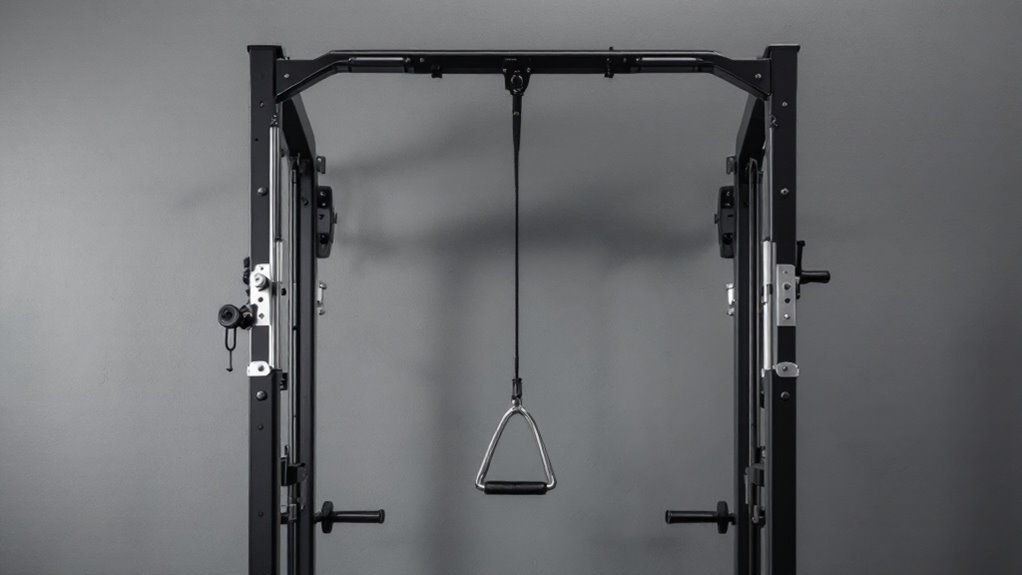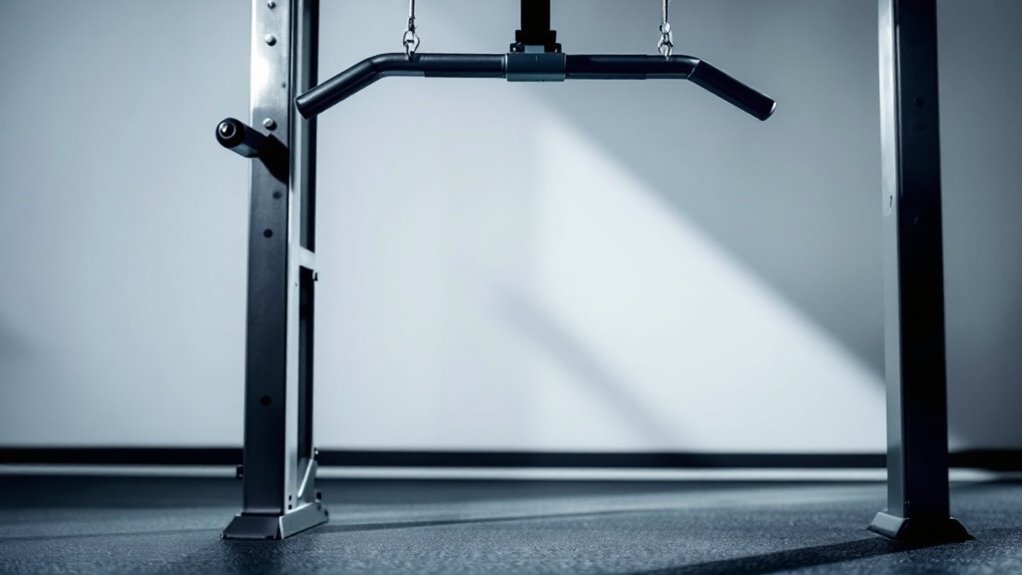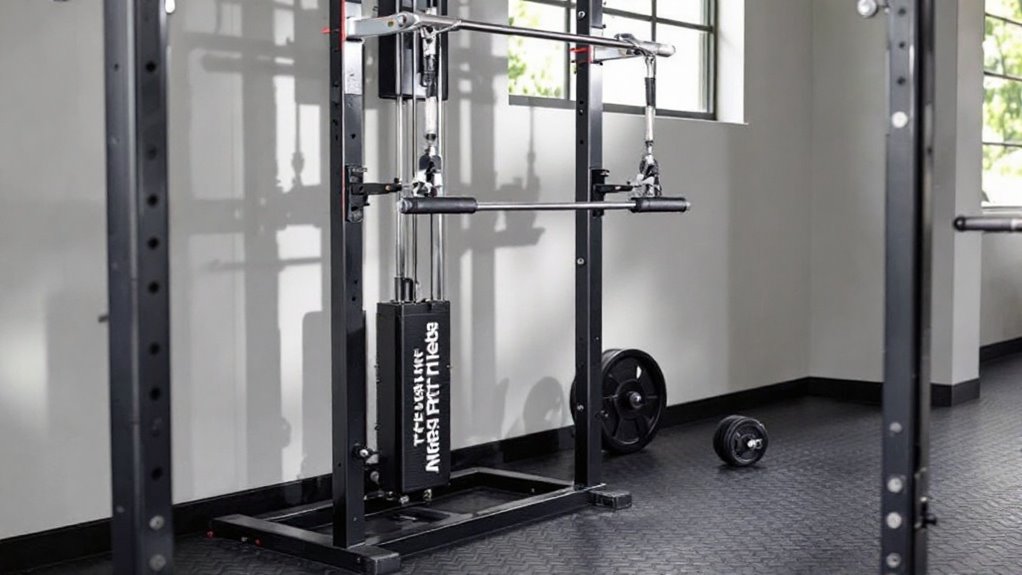Standing Cable Row

The standing cable row develops strength and muscle mass in the back while improving posture through controlled pulling movements. Proper form requires shoulder-width stance, active core, and a 45-degree forward lean with straight back. The exercise primarily targets the latissimus dorsi, rhomboids, and rear deltoids while activating secondary muscles like biceps and core stabilizers. Progressive overload and proper technique enhance results. Mastering this foundational movement opens up advanced variations for continued growth.
Key Takeaways
- Stand with feet shoulder-width apart, knees bent, and lean forward at 45 degrees while maintaining a straight back.
- Hold cable handles with palms facing each other and pull toward midsection while driving elbows back to engage lats.
- Target muscles include latissimus dorsi, rhomboids, and rear deltoids, with secondary activation of biceps and core.
- Return weight in a controlled manner while maintaining tension, avoiding momentum or rounding of the lower back.
- Progress gradually with proper form before attempting variations like single-arm rows or wider grip positions.
Proper Form and Technique

Mastering proper form for the standing cable row begins with establishing a solid foundation. Stand with feet shoulder-width apart, knees slightly bent, and core activated. Lean forward at a 45-degree angle while maintaining a straight back.
Grasp the cable handles with palms facing each other. Initiate the movement by pulling the handles toward your midsection, driving elbows back while squeezing shoulder blades together. Keep upper arms close to the body throughout the motion.
Pull with control, keeping your arms tight to your body as you draw the handles in, focusing on engaging your back muscles.
Slowly return to the starting position with controlled movement, maintaining tension in the lats.
Avoid common mistakes like swinging the torso or using momentum to complete the exercise.
This exercise complements external shoulder rotation movements to build comprehensive upper body stability.
Benefits and Muscle Groups Targeted

The standing cable row delivers an extensive upper body workout by engaging multiple muscle groups simultaneously. This compound exercise primarily targets the lattisimus dorsi, rhomboids, and rear deltoids while engaging secondary muscles like the biceps and core stabilizers.
| Muscle Group | Function | Benefit |
|---|---|---|
| Back | Pull & Control | Improved Posture |
| Arms | Support & Curl | Increased Strength |
| Core | Stabilize | Better Balance |
Regular practice of standing cable rows improves posture, prevents muscular imbalances, and builds functional strength essential for daily activities. The exercise also boosts grip strength and promotes overall upper body development while minimizing joint stress. Following a progressive overload approach helps ensure continued strength gains and muscle development over time.
Common Mistakes to Avoid

While performing standing cable rows can dramatically improve upper body strength, exercisers commonly make critical mistakes that reduce effectiveness and increase injury risk.
Key mistakes include rounding the lower back, jerking the weight with momentum instead of controlled movement, leaning too far forward or backward, and failing to maintain proper shoulder blade positioning.
Avoid compromising form during cable rows – control the movement, maintain proper posture, and keep shoulder blades stable throughout the exercise.
Many also use excessive weight, compromising form and muscle involvement. Another common error is neglecting to keep the core braced throughout the movement. This destabilizes the spine and reduces power transfer.
Moreover, moving the elbows too far away from the body decreases lat activation and places unnecessary stress on the shoulders.
Using a weekly exercise planner helps track proper form progression and ensures consistent technique improvement across workouts.
Exercise Variations and Progressions

Successful execution of proper form opens the door to exploring numerous standing cable row variations that target different muscle groups and improve training intensity.
Classic variations include single-arm rows, wide-grip rows, and low-to-high cable pulls.
For progression, athletes can increase resistance gradually, adjust tempo, or incorporate drop sets. Advanced variations include alternating arms, adding rotation, or combining with other movements like squats for compound exercises.
Beginners should master basic form before attempting variations.
Common progressions include:
- Increasing weight by 5-10%
- Adding paused reps
- Changing grip width
- Incorporating unstable stances
- Performing supersets
Maintaining proper recovery time between training sessions allows muscles to repair and grow stronger for optimal progression.
Frequently Asked Questions
How Many Times per Week Should I Do Standing Cable Rows?
Incorporating cable rows 2-3 times per week allows ideal muscle recovery while maintaining consistent training progress.
For beginners, twice weekly with 48-72 hours between sessions is ideal.
Advanced lifters can perform the exercise up to 3 times weekly if properly managing intensity and volume.
Monitor performance and recovery – if form deteriorates or strength plateaus, reduce frequency.
Can I Do Standing Cable Rows if I Have Lower Back Pain?
Exercising with lower back pain requires careful consideration and professional guidance.
While standing cable rows can be performed with proper form, individuals with back issues should first consult a healthcare provider or physical therapist.
If cleared, focus on maintaining neutral spine position, engaging core muscles, and using lighter weights.
Alternative exercises like seated rows might be safer until back pain improves.
Never push through pain that worsens during exercise.
What Weight Should Beginners Start With for Standing Cable Rows?
Beginners should start with a light weight of 20-30 pounds to master proper form and technique.
This allows them to focus on engaging the correct muscles while maintaining balance and stability.
After establishing good form through 2-3 sets of 12-15 reps with perfect execution, they can gradually increase the weight by 5-10 pounds when the current weight feels too easy.
Are Standing Cable Rows Better Than Seated Cable Rows for Building Mass?
Studies show that exercises performed in a standing position involve up to 20% more core muscles compared to seated variations.
Both standing and seated cable rows are effective for building back mass, with neither having a clear advantage for hypertrophy.
The key difference lies in functional strength and core involvement.
Standing rows better mimic real-world movements and improve overall stability, while seated rows allow for stricter form isolation.
Should I Use Lifting Straps When Performing Standing Cable Rows?
Lifting straps are generally unnecessary for cable rows since the weight used is typically moderate and grip strength isn't usually a limiting factor.
However, straps can be beneficial for higher-volume training or when grip fatigue is hindering performance.
Focus on developing natural grip strength first, and only consider straps if grip becomes the weak link in achieving proper form and target muscle activation.
Final Thoughts
The standing cable row remains a cornerstone exercise for developing a strong, defined back while improving posture and core stability. Like a medieval archer drawing their bow, this movement builds functional strength that translates to everyday activities. When performed correctly with proper form and progressive overload, it delivers impressive results. By avoiding common mistakes and exploring variations, fitness enthusiasts can enhance the benefits of this versatile exercise.


